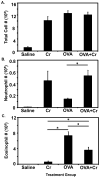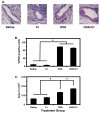Exposure to particulate hexavalent chromium exacerbates allergic asthma pathology
- PMID: 22178736
- PMCID: PMC3288173
- DOI: 10.1016/j.taap.2011.12.001
Exposure to particulate hexavalent chromium exacerbates allergic asthma pathology
Abstract
Airborne hexavalent chromate, Cr(VI), has been identified by the Environmental Protection Agency as a possible health threat in urban areas, due to the carcinogenic potential of some of its forms. Particulate chromates are produced in many different industrial settings, with high levels of aerosolized forms historically documented. Along with an increased risk of lung cancer, a high incidence of allergic asthma has been reported in workers exposed to certain inhaled particulate Cr(VI) compounds. However, a direct causal association between Cr(VI) and allergic asthma has not been established. We recently showed that inhaled particulate Cr(VI) induces an innate neutrophilic inflammatory response in BALB/c mice. In the current studies we investigated how the inflammation induced by inhaled particulate Cr(VI) might alter the pathology of an allergic asthmatic response. We used a well-established mouse model of allergic asthma. Groups of ovalbumin protein (OVA)-primed mice were challenged either with OVA alone, or with a combination of OVA and particulate zinc chromate, and various parameters associated with asthmatic responses were measured. Co-exposure to particulate Cr(VI) and OVA mediated a mixed form of asthma in which both eosinophils and neutrophils are present in airways, tissue pathology is markedly exacerbated, and airway hyperresponsiveness is significantly increased. Taken together these findings suggest that inhalation of particulate forms of Cr(VI) may augment the severity of ongoing allergic asthma, as well as alter its phenotype. Such findings may have implications for asthmatics in settings in which airborne particulate Cr(VI) compounds are present at high levels.
Copyright © 2011 Elsevier Inc. All rights reserved.
Conflict of interest statement
The authors declare they have no competing financial interests.
Figures





References
-
- Adams RJ, Wilson DH, Taylor AW, Daly A, Tursan dE, Dal Grande E, Ruffin RE. Coexistent chronic conditions and asthma quality of life: a population-based study. Chest. 2006;129:285–291. - PubMed
-
- Borish L, Culp JA. Asthma: a syndrome composed of heterogeneous diseases. Ann Allergy Asthma Immunol. 2008;101:1–8. - PubMed

